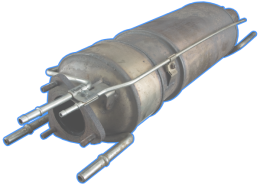

Introduction to Diesel Particulate Filters (DPF)
 Diesel particulate filters have been used by some vehicle manufacturers for several years now, but only since about 2009 has it been mandatory for all vehicles to be fitted with them to help achieve strict new Euro 4, 5 and 6 emissions.
Diesel particulate filters have been used by some vehicle manufacturers for several years now, but only since about 2009 has it been mandatory for all vehicles to be fitted with them to help achieve strict new Euro 4, 5 and 6 emissions.
These filters can often be confused with catalytic converters or silencer boxes since they look similar and are usually incorporated as part of the exhaust front pipe near to the engine.
Their purpose is to trap diesel particulate matter, or soot, as it’s often referred to. All diesel engines smoke under hard acceleration, especially when cold, due to the entire diesel not being burnt. Even with the major advances in high pressure common rail diesel systems not all of the diesel combusts and this can be seen as black smoke coming from the vehicles tailpipe where a DPF isn’t used. If you observe a diesel vehicle that’s accelerating and there isn’t any smoke being emitted it’s more than likely fitted with a DPF.
Sooner or later, depending mainly on driving style or conditions, these filters become restricted or blocked but vehicle manufacturers have taken steps to help prevent this from happening. Periodically these filters need to be cleaned or emptied but without removing them from the vehicle, this process is often referred to as DPF Regeneration.
The engine management system monitors the DPF’S soot fill percentage and decides when regeneration is necessary. As well as monitoring the DPF’S back pressure to detect a partially blocked filter, some ECU’s are programmed to carry out regeneration based on mileage covered or hours driven.
